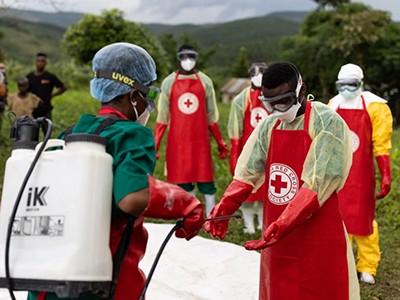[ad_1]
Uganda’s most recent Ebola outbreak should be a wake-up call to the world. Last October, just 3 weeks into the outbreak, the disease spread to Kampala, a well-connected city of 1.5 million people. From there, it might easily have entered other countries.
As the incident manager at the Ugandan Ministry of Health, I coordinated all technical and operational aspects of the Ebola response. We worked tirelessly to curtail the spread, and declared the end of the outbreak on 11 January. But the quarantines and lockdowns came at a high cost, especially for the country’s poorest people.
We need a better way. The world did not rely solely on lockdowns, quarantines and contact tracing to fight COVID-19. When rich countries are affected by a fatal infectious disease, there is a massive global effort to develop vaccines and therapeutics.
Vaccine incentives do not backfire — policymakers take note
Preventive, not reactive, vaccination is needed to fight Ebola. Wealthier nations must urgently fund mapping efforts and vaccine production to protect vulnerable populations in sub-Saharan Africa and, through them, the rest of the world.
Ebola outbreaks have cropped up almost every year since 2000 in Central and West Africa. Their frequency is likely to increase. With habitat destruction plus the heat, drought and other extreme weather brought on by the climate crisis, the animals that carry the virus will migrate, coming into more contact with people.
Since the first Ebola outbreaks in 1976, control has relied on the same tools: contact tracing, quarantine of confirmed cases, safe and dignified burials, and lockdowns. These measures work best in the sparsely settled countryside, and alone are not viable in dense, complex urban settings.
I was distraught when Ebola reached Kampala. I had been in Freetown, the capital of Sierra Leone, during the West African Ebola crisis of 2014–16. Relying on contact tracing and quarantine failed us there — transmission continued for several months. I was afraid it would do so again.
Institutional quarantine, meaning separating people who have been exposed to Ebola from their families in an isolation facility for 21 days, or even just quarantining at home, can be hard enough for those who have relatives to care for, or who need those 21 days of income to feed their families. But the measures we were forced to take in Kampala included 63 days of lockdown in two rural districts with a combined population of nearly one million.
Can mRNA vaccines transform the fight against Ebola?
The effect on people’s livelihoods and on the local timber industry was devastating. The societal disruptions that these interventions bring fuel people’s anger and distrust of public-health efforts. And they are not the only way to curb the spread of the disease.
Ebola is localized in a band across Central and West Africa. High-risk regions include areas in Uganda, the Democratic Republic of the Congo, Gabon, Sierra Leone, Liberia, South Sudan, the Ivory Coast and Ghana. Certain areas in these countries have evidence of Ebola transmission or are close to the habitats of animals that might be Ebola reservoirs, such as fruit bats. Researchers could map the populations in these countries that are at greatest risk and target them for vaccination, staving off future epidemics.
Mapping would combine three techniques: testing human blood samples for Ebola, testing blood samples from domestic and wild animals and disease modelling. For human blood samples, there is a cheap, easy way to get started: testing stored samples from nationwide HIV surveys, which many of these countries already have. For example, Uganda has the 2004–05 HIV serosurvey. We could use the results of testing these samples for Ebola to target specific geographic areas for new surveys. But African nations will need support: funding for reagents, and expertise in serosurvey design and disease modelling.
Then, we need enough Zaire-strain Ebola vaccine to vaccinate entire populations in the targeted areas. In places that have seen Ebola outbreaks, vaccine acceptance is high. Areas that have not had an outbreak will be a greater challenge, and we must invest in tailored communication and culturally sensitive ways to engage with communities to gain their trust.
A full picture of the longevity of vaccine-induced immunity is unknown for Ebola, but existing evidence is relatively encouraging (Z. A. Bornholdt and S. B. Bradfute Lancet Infect. Dis. 18, 699–700; 2018). Antibody levels in the blood decrease over six months to one year, but how long T-cell immunity lasts is unknown. More data are needed, but an annual vaccine could be plausible.
Although there are approved vaccines for the Zaire strain of Ebola, this latest outbreak was caused by the Sudan strain. Comprehensive, preventive vaccination would require Sudan-strain vaccines, so global institutions need to funnel money to the entities that are developing and trialling such vaccines. More than 5,000 doses of trial vaccines arrived in Uganda just as the outbreak was ending, and the planned clinical trials must be redesigned to generate more safety and effectiveness data.
Ebola isn’t going anywhere. The wisest use of this time between outbreaks is to map high-risk areas and vaccinate those in them, instead of waiting for another outbreak. The global community has an opportunity to get it right — and to protect the world.
Competing Interests
The author declares no competing interests.
[ad_2]
Source link



